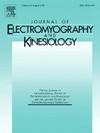Establishing a methodological framework for evaluating gait symmetry through muscle synergies: A pilot study
IF 2.3
4区 医学
Q3 NEUROSCIENCES
引用次数: 0
Abstract
Gait symmetry is vital for stable locomotion, yet conventional metrics often yield inconsistent results. Muscle synergy analysis provides a more precise understanding of neural mechanisms behind symmetric gait. A clear methodology is essential to distinguish true inter-limb differences from natural variability. This study aimed to refine the analysis of muscle synergy symmetry in healthy individuals by incorporating intra-limb similarity as a baseline for comparison, while also including muscle weightings within each synergy to explore muscle synchrony. EMG signals were collected from both lower limbs of healthy subjects during treadmill walking. Muscle synergies were extracted using non-negative matrix factorization (NMF). Intra-limb similarity was used as a baseline to assess inter-limb differences. Muscle activity, number of synergies, muscle weightings within each synergy, and weight (W) and activation coefficients (H) were compared between sides. Normalized scalar products assessed weight coefficients, while Pearson’s correlation was used to compare activation coefficients. No significant differences were found in the number or structure of muscle synergies between limbs, indicating symmetrical coordination. However, significant differences were observed in activation of four of eight muscles and minor variations in muscle weightings. This study underscores the importance of a robust framework for interpreting muscle synergy symmetry.
通过肌肉协同作用建立评估步态对称性的方法学框架:一项试点研究
步态对称对于稳定的运动至关重要,然而传统的指标往往产生不一致的结果。肌肉协同分析为对称步态背后的神经机制提供了更精确的理解。要区分真正的肢间差异和自然变异,明确的方法至关重要。本研究旨在通过将肢体内相似性作为比较基线,同时还包括每个协同作用中的肌肉权重,以探索肌肉同步,从而完善健康个体肌肉协同对称性的分析。采集健康受试者在跑步机上行走时的双下肢肌电信号。使用非负矩阵分解(NMF)提取肌肉协同作用。采用肢内相似性作为评估肢间差异的基线。比较两侧的肌肉活性、协同作用数量、每个协同作用内的肌肉重量、体重(W)和激活系数(H)。归一化标量积评估权重系数,而皮尔逊相关性用于比较激活系数。四肢间肌肉协同作用的数量和结构均无显著差异,说明四肢间肌肉协同作用是对称的。然而,8块肌肉中有4块的激活程度有显著差异,肌肉重量也有细微变化。这项研究强调了解释肌肉协同对称性的强大框架的重要性。
本文章由计算机程序翻译,如有差异,请以英文原文为准。
求助全文
约1分钟内获得全文
求助全文
来源期刊
CiteScore
4.70
自引率
8.00%
发文量
70
审稿时长
74 days
期刊介绍:
Journal of Electromyography & Kinesiology is the primary source for outstanding original articles on the study of human movement from muscle contraction via its motor units and sensory system to integrated motion through mechanical and electrical detection techniques.
As the official publication of the International Society of Electrophysiology and Kinesiology, the journal is dedicated to publishing the best work in all areas of electromyography and kinesiology, including: control of movement, muscle fatigue, muscle and nerve properties, joint biomechanics and electrical stimulation. Applications in rehabilitation, sports & exercise, motion analysis, ergonomics, alternative & complimentary medicine, measures of human performance and technical articles on electromyographic signal processing are welcome.

 求助内容:
求助内容: 应助结果提醒方式:
应助结果提醒方式:


